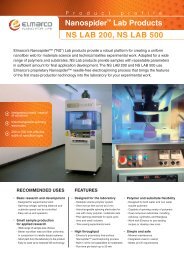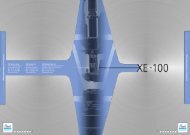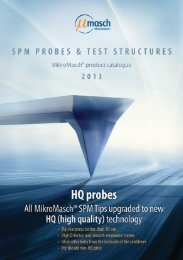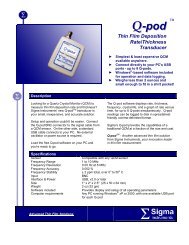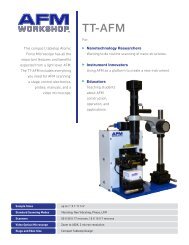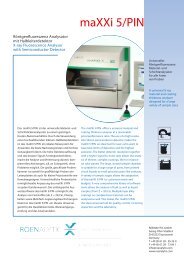easyScan 2 brochure (1.1 MB) - Schaefer Technology
easyScan 2 brochure (1.1 MB) - Schaefer Technology
easyScan 2 brochure (1.1 MB) - Schaefer Technology
Create successful ePaper yourself
Turn your PDF publications into a flip-book with our unique Google optimized e-Paper software.
Nanosurf ® <strong>easyScan</strong> 2<br />
Scanning Probe Microscopes - Your Modular System
Perfect Modularity<br />
Nanosurf’s <strong>easyScan</strong> series has gained worldwide popularity through its affordability, portability, and ease of use, with hundreds<br />
of systems currently in use. Now its successor, the <strong>easyScan</strong> 2, unites these three unique characteristics with a fully modular<br />
system design. Whether you need a teaching tool, a training Scanning Probe Microscope, or a research instrument, what you<br />
need is what you get.<br />
<strong>easyScan</strong> 2<br />
STM Vibration Isolation Platform<br />
<strong>easyScan</strong> 2<br />
STM Scan Head<br />
500 nm<br />
<strong>easyScan</strong> 2<br />
STM Scan Head<br />
1 µm<br />
<strong>easyScan</strong> 2<br />
STM Scan Head<br />
500 nm LC<br />
<strong>easyScan</strong> 2<br />
STM Scan Head<br />
1 µm LC<br />
Transport Case<br />
<strong>easyScan</strong> 2<br />
Controller<br />
Nanosurf Analysis<br />
Nanosurf Report<br />
<strong>easyScan</strong> 2<br />
Scripting Interface<br />
<strong>easyScan</strong> 2<br />
Signal Module A<br />
<strong>easyScan</strong> 2<br />
Signal Module S<br />
The diagram above illustrates the major <strong>easyScan</strong> 2 components and modules in their possible combinations. The <strong>easyScan</strong> 2<br />
Controller forms the backbone of the system. In its basic state it is able to control any <strong>easyScan</strong> STM Scan Head – it is up to<br />
you to choose which of the four STM Scan Heads best fits your needs. Adding the AFM Basic Module allows it to control any<br />
<strong>easyScan</strong> AFM Scan Head and to measure in Static Force mode. With the AFM Dynamic Module dynamic force measurements<br />
become possible. The AFM Mode Extension Module extends your system by including Phase Contrast, Force Modulation, Spreading<br />
Resistance, Magnetic Force and Electrostatic Force mode. The three AFM Scan Heads differ in scan range and resolution only,<br />
with the exterior colour scheme setting apart the general purpose 70µm head from the more specialised 110µm head (large<br />
scan) and the 10µm head (high resolution). The latter in particular benefits from the addition of the Micrometer Translation<br />
Stage, which serves to position the sample precisely and reproducibly for spot measurements.<br />
2
Key Features and Benefits<br />
• Modular: Expandable to suit user needs<br />
• Portable and compact: Transportable and easy to install with a small footprint<br />
• Easy to use: Designed for quick and reliable measurements by experts and novices alike<br />
• Affordable: Unique price/performance ratio for research and teaching<br />
• Swiss made: Top quality ensures your satisfaction<br />
<strong>easyScan</strong> 2<br />
AFM Scan Head<br />
70 µm<br />
<strong>easyScan</strong> 2<br />
AFM Scan Head<br />
10 µm<br />
<strong>easyScan</strong> 2<br />
AFM Scan Head<br />
110 µm<br />
<strong>easyScan</strong> 2<br />
AFM Sample Stage<br />
<strong>easyScan</strong> 2<br />
AFM Micrometer Translation Stage<br />
<strong>easyScan</strong> 2<br />
AFM Basic Module<br />
<strong>easyScan</strong> 2<br />
AFM Video Module<br />
<strong>easyScan</strong> 2<br />
AFM Dynamic Module<br />
<strong>easyScan</strong> 2<br />
AFM Mode Extension Module<br />
With such complete modularity, the user alone decides where to begin. You can start exploring the details of your nanometric<br />
world with the STM and add an AFM later; or begin with a Basic AFM Package and add Dynamic Force capacities later; or first<br />
simply add a Signal Module to the STM – all of these possibilities and many more are yours with the <strong>easyScan</strong> 2. You can tailor<br />
your system to your needs and your resources and expand it later at will as needs and resources grow! The <strong>easyScan</strong> 2 is more<br />
affordable, portable, and easy to use than ever, making it an essential tool for teaching, training, developing and research in<br />
nanotechnology – browse through the following pages for a few concrete examples.<br />
Accessories and Additional Products<br />
We offer various sample or calibration kits,<br />
tool sets etc. Please visit our internet page<br />
www.nanosurf.com or contact your local<br />
distributor for further information.<br />
3
Flexible <strong>easyScan</strong> 2 Software<br />
The <strong>easyScan</strong> 2 software is a dedicated SPM software tailored to the modularity of the <strong>easyScan</strong> 2 system. It adapts itself to<br />
the system and scan head currently in use by automatically detecting the scan head type and changing the control options to<br />
reflect the system configuration. It also allows the user to set the level of interface complexity, from an easy level where the<br />
most important parameters can be set in a simple manner to an advanced level that offers detailed control but also requires<br />
a more comprehensive theoretical knowledge. This user interface level can be chosen independently of the scan head and can<br />
be changed at any time.<br />
Spectroscopy windows and imported data to<br />
• Clear and intuitive interface: Minimal instrument training time<br />
spreadsheet<br />
• Automatic system recognition: Identical user interface independent of system configuration<br />
• Three user interface levels: Easy, Standard, Advanced<br />
• Real-time parameter adjustment and analysis: Fast results and full control<br />
• Standard analysis tools integrated: background subtracting, filtering, section analysis, 3D images, height, distance, angle<br />
measurements<br />
• Modular, adaptable to user needs through additional Software: <strong>easyScan</strong> 2 Scripting Interface, Nanosurf Report or Analysis<br />
Real-time Performance<br />
Whatever the system or the user interface, the <strong>easyScan</strong> 2 software reacts in real-time to user input. Even while measuring, the<br />
scan and acquisition parameters can be adjusted, the imaging window can be arranged to monitor all signals simultaneously,<br />
the image area, size, and online analysis can be adapted, and features of the current image can be analysed.<br />
Powerful Software Components<br />
To further enhance your system, simply add any of our three additional software modules: Nanosurf Report, Nanosurf Analysis<br />
and the <strong>easyScan</strong> 2 Scripting Interface. Joining these modules to the basic <strong>easyScan</strong> 2 software opens up your system to<br />
powerful measurement analyses as well as customised functions and automation.<br />
4
Nanosurf Report – Image Processing and Reporting<br />
Nanosurf Report enables mathematical image treatment and<br />
analysis, from filtering out of noise and waviness to generating 3D<br />
representations, volumetric measurements and standard roughness<br />
parameters of the inspected surface. Users with repetitive tasks at<br />
hand will benefit in particular from the automated report generating<br />
possibilities. Here, a template report can be applied to a whole array<br />
of similar measurements, ensuring quick, reliable and reproducible<br />
analysis. Nanosurf Report documents allow certification of quality<br />
control processes by keeping track of all operations applied to the<br />
images.<br />
• Complete report creation: Creation of meaningful, visually<br />
appealing, professional reports - including measurement<br />
analysis, text commentaries, logos, time stamp and images<br />
• Automated report generation: Efficient generation of standard<br />
reports with templates<br />
• Able to read multiple file formats of other instrument<br />
manufacturers<br />
Nanosurf Analysis – Image Analysis and Processing<br />
Nanosurf Analysis enables advanced mathematical image treatment<br />
and analysis, from filtering, calibration, tip characterisation, extended<br />
Fourier analysis, grain analysis, force curve analysis, movie and time<br />
series analysis to generating photorealistic 3D representations of<br />
the inspected surface.<br />
• Advanced measurement and analysis: Extract the information<br />
you need<br />
• Noise reduction and feature enhancement: Visualise the true<br />
surface<br />
• Extensive calibration and tip characterisation possibilities:<br />
Know your measuring equipment<br />
• Able to read over 50 file formats of other instrument<br />
manufacturers<br />
<strong>easyScan</strong> 2 Scripting Interface - Unlimited Freedom<br />
The <strong>easyScan</strong> 2 Scripting Interface allows the user to control<br />
the instrument behaviour with user-defined Visual Basic scripts.<br />
Customise spectroscopy, z-controller, operating mode parameters,<br />
and user I/O; Create new documents and charts; add mathematical<br />
operations such as histograms, filters, and correlations; and exploid<br />
control functions for special applications. The Scripting Interface also<br />
allows coordination with external programs via Microsoft standard<br />
COM automation. In this way, even not so easy measurements can<br />
be performed with our distinctive easy to use software.<br />
• Control over the measurement: Lithography, nano-manipulation,<br />
complex spectroscopy, automated measurements<br />
• Expandable software through scripting: User-defined data analysis<br />
capabilities<br />
• Built-in Visual Basic script editor: No external compilers needed<br />
• COM Automation: Coordination with external programs (e.g. LabView)<br />
5
Basic STM Package<br />
The first scanning tunneling microscope (STM) was developed by Gerd Binnig and Heinrich Rohrer from the IBM research<br />
laboratory in Rüschlikon, Switzerland, and first made atoms accessible to trained scientists. The <strong>easyScan</strong> 2 STM goes a step<br />
further and makes atoms accessible for everyone.<br />
This is why, around the globe, hundreds of <strong>easyScan</strong> STMs form a crucial part of nanoeducation, whether in the framework<br />
of physics, chemistry, or materials science. Teachers appreciate the easy and hassle-free classroom demonstrations they can<br />
offer, and students find themselves motivated by the rapid success of their first step into practical nanoscience, be it in a lab<br />
assignment or a research project, in high school or graduate studies. Tips for the STM are simply cut from a Pt/Ir wire without<br />
any etching in hazardous substances, and the <strong>easyScan</strong> system’s low voltage further ensures the operator’s safety.<br />
The <strong>easyScan</strong> STM has also established itself as a full-fledged research and development tool. Applications range from routine<br />
process control such as spot-checking nanocircuitry to fundamental research such as single electron spin detection and<br />
spectroscopy. Now, with the <strong>easyScan</strong> 2 series and its Signal Module, scientists can expand the possibilities of their <strong>easyScan</strong><br />
STM even further. And, thanks to its ease of use, those who want to use their STM for student labs can, without fearing damage<br />
to their research equipment.<br />
• Atomic lattice image of graphite<br />
• Dotriacontan thin film (organic layer)<br />
(by Dr. J. Francis Wolf, HU-Berlin, Germany)<br />
• NanoGrid<br />
• Charge density waves on TaS 2<br />
• Easy to use: Ideal for nanotechnology education and outreach<br />
• Quick atomic resolution on a normal table: No need for expensive vibration isolation<br />
• Portable and compact: Transportable, easy to install with a small footprint<br />
• Accessible sample stage and scanning tip: Quick exchange of tip and sample<br />
• Low operating voltage: Safe for all users<br />
6
Basic AFM Package<br />
The <strong>easyScan</strong> 2 Basic AFM Package masters topography imaging, force spectroscopy and lithography in Static Force mode<br />
– the fundamental functions for surface measurement and modification. Along with its easy handling and positioning and its<br />
capability of measuring on nearly any sample size and geometry, these features make this the ideal package for use in all entry<br />
level situations. Give students an <strong>easyScan</strong> 2 Basic AFM Package, and they will learn about surface roughness, interatomic<br />
forces, hardness, and feedback loops. Give teachers an <strong>easyScan</strong> 2 Basic AFM Package, and they will teach their class about ultra<br />
large scale integration, corrosion, surface tension, and the limitations of optics. Give a small or medium enterprise an <strong>easyScan</strong><br />
2 Basic AFM Package, and they will have a tool to inspect their surfaces that can upgrade its measurement capabilities as their<br />
technology advances, a flexibility unique to the <strong>easyScan</strong> 2 system.<br />
Smart <strong>Technology</strong><br />
Instead of piezoelectric materials that require high voltages and are vulnerable to creep, the <strong>easyScan</strong><br />
2 AFM uses a patented open-loop electromagnetic scanner that boasts an XY–Linearity Mean Error of<br />
less than 0.6% with low noise and low power consumption. This and similar smart design features<br />
allow a reduction in cost without a loss of precision performance. The Basic AFM Package makes<br />
professional high resolution surface measurements available to everyone.<br />
PS/PMMA film<br />
scan size: 5µm - z-range: 10nm<br />
• Skin Cross Section<br />
• Carbon Nanotubes<br />
• Silica Beads<br />
• Silica Beads, high resolution<br />
• Portable, compact atomic force microscope: Fits in every lab<br />
• Stand-alone design: Able to measure on small and large samples alike<br />
• Easy to use, dual lens and automatic approach: Ideal for nanotechnology<br />
education and outreach<br />
• Cantilever Alignment Chip technology: Easy tip change without laser adjustment<br />
• World’s least expensive commercial AFM<br />
Spectroscopy window<br />
7
Basic Dynamic AFM Package<br />
More often than not, the sample dictates the measurement mode. Soft, sensitive or sticky samples suffer under static force,<br />
even if the forces amount to less than 20 nN.<br />
The Dynamic Force Module offers an ideal solution. Instead of tracing the topography line upon line with a constant force,<br />
the cantilever is vibrated near its resonance frequency and scanned across the surface with a constant vibration amplitude,<br />
thus experiencing only intermittent contact with the surface. In this manner, dynamic force microscopy eliminates potentially<br />
damaging lateral forces, making it the method of choice for many AFM measurements. The Basic Dynamic AFM Package is ideal<br />
for introducing students to the Dynamic Force mode.<br />
• All the advantages of the Basic AFM<br />
• Dynamic Force Module: Measure sensitive samples and loosely attached particles with ease<br />
• Intermittent contact: Prevent measuring artefacts of surface capillary forces<br />
A)<br />
Gold colloids on silicon<br />
Staphylococcus Aureus Bacteria<br />
B)<br />
A) Static force AFM, scanning artefacts are seen<br />
B) Dynamic force AFM, no scanning artefacts<br />
Simple Cantilever Replacement<br />
Changing the cantilever takes three easy steps:<br />
cover the scanner with the DropStop, lift the<br />
cantilever holder, and replace the cantilever. When<br />
the cantilever holder is released and the DropStop<br />
removed, the Probe Status LED stops flashing and<br />
confirms the AFM is ready to measure.<br />
Professional surface measurements require professional equipment. Starting with our Basic AFM Package we use only top quality<br />
cantilevers fitted with the alignment chip mounting system pioneered by NanoWorld.<br />
Easy Positioning<br />
The two view lenses built into the<br />
<strong>easyScan</strong> 2 AFM offer a top view<br />
that shows where on the sample the<br />
cantilever is positioned and a side<br />
view that shows the probe-sample<br />
distance. Positioning the sample for<br />
measurement thus becomes simple<br />
and intuitive.<br />
8
Multiple Mode Package<br />
Users who want to measure more than topography will appreciate the Multiple Mode Package, which adds Phase Contrast, Force<br />
Modulation, Scanning Spreading Resistance, Magnetic Force and Electrostaticforce modes to its standard Static and Dynamic<br />
Force capabilities. The <strong>easyScan</strong> 2 STM, also part of this package, provides the possibility of further analysis of conductive<br />
samples.<br />
Thin layer of a blend of PS/PMMA film. Topography / phase contrast<br />
Magnetic hard disk. Topography / magnetic bits<br />
The Phase Contrast mode images the phase shift of the resonance frequency, which is influenced by changes in the mechanical<br />
or chemical properties of the sample surface, allowing simultaneous imaging of material contrast and sample topography.<br />
Magnetic Force Microscopy is an extension of the Phase Contrast mode, using a magnetically coated tip to detect local changes<br />
in sample magnetisation, and the Scanning Spreading Resistance mode uses an electrically conducting tip to map local<br />
resistivity. All these modes allow the detection of features not visible in pure topography measurements: “sticky” areas, data<br />
storage bits, and leakage current, to name a few examples.<br />
To facilitate positioning, the Multiple Mode Package includes the Video Module, which shows the views through the two lenses<br />
directly on the computer screen. The video image, which can be switched between the two views, can be saved for further<br />
reference.<br />
• AFM Mode Extension Module: Additional measuring modes and sample information<br />
• Dual lens video camera: Inspect the cantilever position on your computer screen<br />
• STM Scan Head: AFM complement for research and education<br />
Dual lens video camera<br />
STM scan head<br />
9
Advanced Research Package<br />
The Advanced Research Package goes a step further. Not only does it offer all the capabilities of the Multiple Mode Package,<br />
it also offers access to and control of all the relevant electronic signals and full COM automation with the Signal Module A<br />
and <strong>easyScan</strong> 2 Scripting Interface, resulting in a full-fledged research microscope with the typical Nanosurf ease of use. The<br />
user can modulate driving signals or the scanner position at will, opening up possibilities of lithography and experimental<br />
microscopy. All signals are accessed and modulated via standard BNC connections. The results can be analysed in depth and<br />
presented in professional standard reports.<br />
While some customers with basic systems may already need a scan head other than the standard mid-range model, owners<br />
of the Advanced Research Package will benefit even more from the high resolution Scan Head or the large range Scan Head.<br />
The former allows measurements of atomic steps and minuscule features, while the latter allows the metrology of volumes of<br />
up to 200’000µm 3 . Switching between scan heads requires nothing more than loading the calibration file that corresponds to<br />
the head plugged into the controller. This is nano-exploration at its most versatile, the result of successively expanding the<br />
<strong>easyScan</strong> 2 system.<br />
Scripting Interface examples: External instrument control with Lab View<br />
Histogram analysis with built-in Visual Basic script<br />
• Nanosurf Analysis or Nanosurf Report: Complete data analysis and reporting software<br />
• <strong>easyScan</strong> 2 Scripting Interface: User-defined customisation and automation<br />
• Signal Module A: More measurement control and modes, more data analysis possibilities<br />
• Micrometer Translation Stage: Position your sample with micrometer precision<br />
10
Nanosurf® <strong>easyScan</strong> 2 Technical Data<br />
Electronics<br />
Electronics size / weight<br />
470 x 120 x 80 mm / 2.4 kg<br />
Power supply<br />
90 - 240 V~/ 30 W 50/60 Hz<br />
Computer interface USB 2.0<br />
Integrated USB hub<br />
2 Ports USB <strong>1.1</strong> (100 mA max)<br />
Measurement channels<br />
16 bit A/D converters, up to seven signals depending on configuration<br />
Scan generator<br />
16 bit D/A converter for all axes<br />
Scan speed<br />
Up to 60ms/line at 128 datapoints/line<br />
Scan drive signals<br />
± 10 V, no high voltage!<br />
Scan area and data points<br />
Individual width/height, up to 2048 x 2048 points<br />
Scan image rotation 0 - 360°<br />
Sample tilt compensation<br />
Hardware X/Y-slope compensation<br />
Spectroscopy modes<br />
Single point measurement or multiple measurements along vector<br />
Spectroscopy measurement averaging 1 - 1024<br />
Spectroscopy data points Up to 2048<br />
Adapters for former <strong>easyScan</strong> Scan Heads available<br />
Scan Software<br />
Various charts of the scan data can be displayed<br />
simultaneously:<br />
Line graph, Colour map, 3D view, ...<br />
Customisable display and parameter settings using user profiles<br />
On-line processing functions Mean fit, polynominal fit, derived data, ...<br />
Quick evaluation functions<br />
Distance, angle, cross section, roughness, …<br />
Data export BMP, ASCII, CSV, ...<br />
Automatic image transfer to offline post processing software Nanosurf Analysis or Nanosurf Report<br />
Computer requirements<br />
Operating system<br />
Electronics interface<br />
Recommended PC hardware<br />
(Computer not included with system)<br />
Windows 2000, XP or newer<br />
USB port<br />
Pentium 4/M or AMD Athlon, 256<strong>MB</strong> RAM, True colour 1024x786 video card, HW Open GL accelerator<br />
Nanosurf <strong>easyScan</strong> 2 Scripting Interface<br />
Applications<br />
Automating measurement tasks, lithography, custom evaluation functions, using third party measurement<br />
equipment, ...<br />
Included control software Windows Scripting Host: Visual Basic Script, Java Script, ...<br />
Remote control by<br />
Nanosurf <strong>easyScan</strong> 2 Signal Module: S<br />
COM compatible languages: LabView, MathLab, Visual Basic, Delphi, C++, …<br />
Available output signals<br />
Full scale corresponds to<br />
Power supply output<br />
X-Axis, Y-Axis, Z-Axis, Approach, Tip Voltage, STM Current or AFM Deflection, Excitation, Amplitude,<br />
Phase<br />
± 10 V, Excitation: ± 5 V<br />
GND, + 15 V, - 15 V<br />
Nanosurf <strong>easyScan</strong> 2 Signal Module: A<br />
All output signals of Signal Module: S<br />
Additional signal modulation inputs<br />
Free connectors<br />
Modulation range<br />
Additional analog user inputs<br />
Additional analog user outputs<br />
Synchronisation output<br />
Additional modes<br />
X-Axis, Y-Axis, Z-Axis, Tip Voltage, Excitation<br />
2 x Aux, connection made on user request<br />
± 10 V, Excitation: ± 5 V<br />
2 x 16 bit A/D converters, ± 10 V<br />
2 x 16 bit D/A converters, ± 10 V<br />
1 x TTL: start, end, point sync<br />
Almost unlimited<br />
User inputs can optionally be measured in all Imaging and Spectroscopy modes<br />
User outputs can be modulated in Spectroscopy measurements<br />
11
Nanosurf® <strong>easyScan</strong> 2 Technical Data<br />
STM measurement<br />
STM Scan Head: 500nm 1µm 500nm LC (low current) 1µm LC (low current)<br />
Maximum Scan range 1) 500 nm 1.0 µm 500 nm 1.0 µm<br />
Maximum Z-range 1) 200 nm 200 nm 200 nm 200 nm<br />
Drive resolution Z 2) 3 pm 3 pm 3 pm 3 pm<br />
Drive resolution XY 2) 7.6 pm 15 pm 7.6 pm 15 pm<br />
Current set point 0.1-100 nA in 25 pA steps 0.02 - 20 nA in 5 pA steps<br />
Imaging modes<br />
Spectroscopy modes<br />
Tip voltage<br />
Constant Current (Topography), Constant Height (Current)<br />
Current-Voltage, Current-Distance<br />
± 10 V in 5 mV steps<br />
Sample approach<br />
Sample size<br />
Stick-slip motor<br />
Max. 10 mm diameter<br />
1) These are typical values<br />
2) Calculated by dividing the maximum range by 16 bits; atomic resolution on HOPG can be obtained with all STMs<br />
AFM measurement<br />
AFM Scan Head: 10µm 70µm 110µm<br />
Maximum Scan range 1) 10 µm 70 µm 110 µm<br />
Maximum Z-range 2 µm 14 µm 22 µm<br />
Drive resolution Z 2) 0.027 nm 0.21 nm 0.34 nm<br />
Drive resolution XY 2) 0.15 nm <strong>1.1</strong> nm 1.7 nm<br />
XY-Linearity Mean Error < 0.6 % < 1.2 % < 0.6 %<br />
Z measurement noise level (RMS,Static Mode) 0.07 nm (max. 0.2 nm) 0.6 nm (max. 0.8 nm) 0.4 nm (max. 0.55 nm)<br />
Z measurement noise level (RMS,Dynamic Mode) 0.04 nm (max. 0.07 nm) 0.5 nm (max. 0.8 nm) 0.3 nm (max. 0.55 nm)<br />
Design<br />
Sample size<br />
Automatic approach<br />
Max. approach speed<br />
Cantilever alignment<br />
Electrical connection to tip<br />
Tripod stand-alone<br />
Unlimited<br />
5 mm<br />
0.1 mm/s<br />
Automatic adjustment<br />
Available<br />
Scan head weight<br />
Sample observation optics<br />
Optical magnification<br />
View field<br />
Sample illumination<br />
350 g<br />
Dual lens system (top/side view)<br />
Top 12 x / side 10 x<br />
Top 4 x 4 mm / side 5 x 3 mm<br />
White LEDs (brightness 0 - 100 %); axial illumination for<br />
top view<br />
1) Manufacturing tolerances are ± 15 % for 10 µm and 70 µm scan heads, ± 10 % for 110µm scan heads<br />
2) Calculated by dividing the maximum range by 16 bits<br />
Video Module<br />
Camera system<br />
Dual video (top/side view)<br />
Magnification<br />
Top 100 x / side 70 x<br />
View field<br />
Top 3.2 x 2.7 mm / side 4.1 x 3.4 mm<br />
Image pixels 352 x 288<br />
Video display<br />
In control software, can be saved as JPEG<br />
Analog video output PAL Video-S<br />
Micrometer Translation Stage<br />
XY resolution < 0.5 µm<br />
Travel<br />
13 mm<br />
AFM Basic Module<br />
Imaging modes<br />
Spectroscopy modes<br />
Tip voltage<br />
Static Force (Contact)<br />
Const. Force (Topography), Const. Height (Deflection)<br />
Force-Distance, Force-Tip voltage<br />
± 10 V in 5 mV steps<br />
The AFM Basic Module is required for using AFM Scan Heads<br />
AFM Dynamic Module<br />
Additional imaging modes<br />
Additional spectroscopy modes<br />
Dynamic frequency range<br />
Dynamic frequency resolution<br />
Dynamic Force (Intermittent Contact, etc.)<br />
Const. Amplitude (Topography), Const. Height (Amplitude)<br />
Amplitude-Distance<br />
15 - 300 kHz<br />
< 0.1 Hz<br />
The AFM Basic Module is required for using the AFM Dynamic Module<br />
AFM Mode Extension Module<br />
Microscopy Made Easy<br />
Nanosurf and the Nanosurf Logo are trademarks of Nanosurf AG, registered and/or otherwise protected in<br />
various countries. Copyright © 2006 Nanosurf AG, Switzerland. Graphic-Design: Hard-Drive Studio<br />
BT02208<br />
<strong>Schaefer</strong> Technologie GmbH<br />
Robert-Bosch-Str. 31<br />
D-63225 Langen<br />
Tel.: +49-(0)6103-30098-0<br />
Fax: +49-(0)6103 30098-29<br />
E-Mail: info@schaefer-tec.com<br />
Web: www.schaefer-tec.com<br />
Additional imaging modes<br />
Additional spectroscopy modes<br />
Phase contrast range ± 90°<br />
Phase contrast resolution < 0.05°<br />
Phase reference range 0 - 360°<br />
Tip current measurement<br />
Phase Contrast, Force Modulation, Spreading Resistance,<br />
Magnetic Force, Electrostatic Force<br />
Phase-Distance, Current-Voltage, Current-Distance, etc.<br />
± 100 µA, 3 nA resolution<br />
Both the AFM Basic Module and the AFM Dynamic Module are required for using the AFM<br />
Mode Extension Module<br />
Compatible Cantilevers NANOSENSORS® and NanoWorld® Applied Nanostructures<br />
Basic Module CONTR, LFMR, ZEILR SICONA<br />
Dynamic Module NCLR, XYNCHR ACLA<br />
Mode Extension Module MFMR, CONTPt, NCLPt, CDT-NCLR<br />
MAGT, FORTA, ANSCM-PC,<br />
ANSCM-PT<br />
Available tips<br />
Standard, SuperSharp Silicon, Rotated pyramidal<br />
HighAspectRatio, Diamond (standard)<br />
Specifications are subject to change without notice



